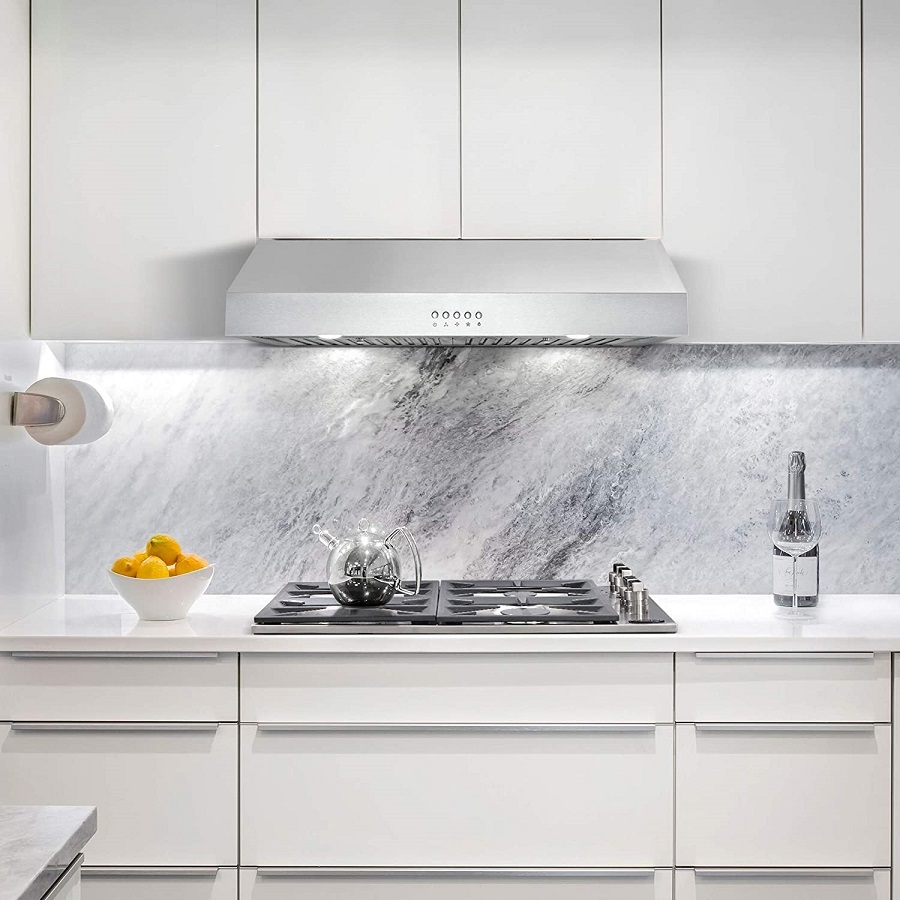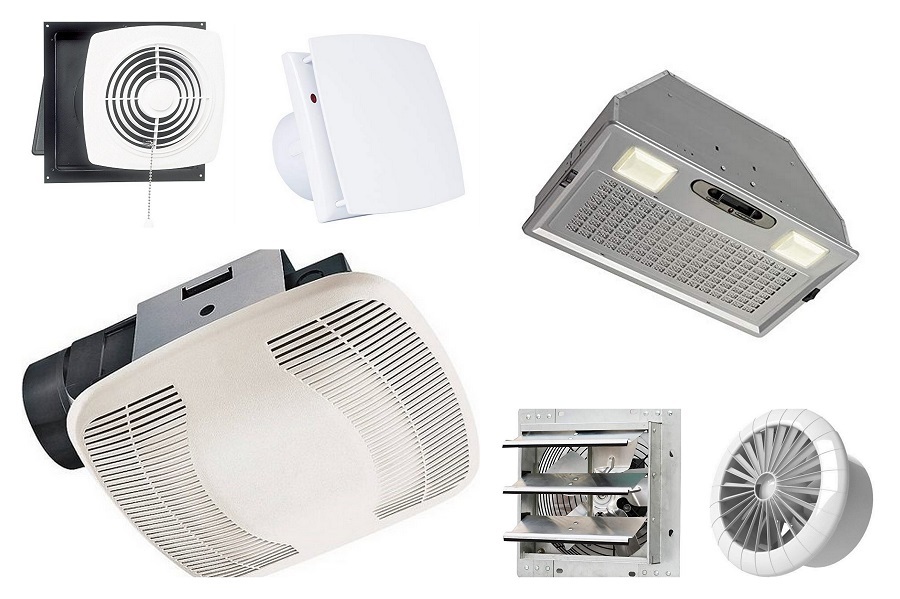Last updated on
The CFM is the best way to exactly tell how powerful the extractor fan of a range hood you need for your gas stove. Here’s how to know.
In a nutshell, the recommendation is 100 CFM per 10,000 BTU. So if you know your gas stove’s total BTU, you can have a rough estimation by simply dropping a couple of zeroes off the number. It’s even easier if you have the manufacturer’s recommendation for your stove.
It is important to note, however, that a single number won’t fit all situations. The CFM needed depends on so many factors and the stove isn’t the only one of them. In this article, we will go over the most important factors.
What's Inside
What is CFM Exactly?

The CFM unit is used to measure different fans’ performance: how good they are at blowing air (how much air they can move per minute). Fan’s capacity is given in cubic feet per minute and typically ranges from 150 for a cordless home fan but can go up to 1000. For extractor fans such as those in range hoods, it defines the amount of air they can suck out of the kitchen per minute.
How Many CFM Does Your Range Hood Need?
Range hoods have an exhaust power that is measured in cubic feet per minute (CFM). With a higher CFM the range good can extract more air from the kitchen. Range Hoods can give your kitchen a cleaner and free scent. Range Hoods have a CFM which is how many Cubic Feet per Minute it can exhaust every minute at full speed.
As a rule of thumb, you need 100 CFM for every 10,000 BTU of your stove. So having a 50,000 BTU stove needs at least 500 CFM. There’s no ideal CFM for a range hood; instead what works best depends on the size and style of the cooktop and cooking habits in the kitchen.
Gas Stove

Check Out the Top 10 Best Range Hoods for Gas Stoves
In general, gas stoves will need a higher CFM than electric counterparts because the gas fumes emit more heat.
Let’s say I want to buy a range for my house, and when I’m deciding what size range to buy, I have to make sure that the range’s ventilation system can match the amount of heat that it will emit from the burners. For example, gas ranges produce a lot of heat, so if you’re cooking under high settings, you need to have an efficient ventilation system. Although this is an important factor in buying your stove, you also want high BTU burners.
To find the required CFM of a range hood over a stovetop that is powered by gas, add the BTU output of each burner. Finally, divide the total number by 10.
For example, a gas stove with 4 burners, 10,000 BTU each has a total BTU of 40,000. Dividing that by 100 equals 400 CFM. So you’ll want a range hood with a minimum CFM of 400 or more.
Kitchen Size

A very simple way to find out how your kitchen size influences the CFM is to divide it’s volume by 4. The rule is based on the recommendation that air in a room needs to be replaced 15 times per hour (60 minutes divided by 15 is 4.)
So to calculate this, multiply the square area of your kitchen by the ceiling height and divide the resulting number by four. For example, a kitchen of 15 by 15 feet with 9 feet ceiling would need ~506 CFM.
Cooking Habits
Let’s talk about cooking habits and the effect they have on how powerful of a range hood one should buy. We suggest that those who cook often or with meat may want to go for a higher CFM because their kitchen will not work well without adequate ventilation.
It is also important to point out that people with less active cooking habits might not need as high, but no one group of people has an “ideal” CFM.
Your diet can also influence the decision when it comes to your cooking style, such as cooks who frequently prepare fish dishes or spicy meals would benefit from having a more powerful CFM than those who either cook infrequently or mainly with soft vegetables and sweetmeats.
Your kitchen does need adequate ventilation, and this article talks about how working type (frequency, types of foods cooked) and dietary preferences impact what kind of range hood you might want.
Duct Size

Did you know that the size of Ducting can influence CFM? As a result of higher CFM ratings on a range hood, larger diameters will be necessary for 8-10 inches to create more suction. Without an adequate size duct, the high CFMs come up with too much air resistance that prevents them from working effectively. Compared to 4-6 inch diameter ducting, smoke and steam should be gone with cooking odors.
Based on study results, it is often proposed that the duct’s width needed to exhaust air from a kitchen is proportional to the power. The width should be 6-8 inches for 400-600 CFM, 7-10 inches for 700-900 CFM, and 8-12 inches for 1200 or greater CFM.
If your duct diameter is bigger, or if it is longer, or there are more turns in it, you increase the CFM in that specific area. You also have a roof cap which can increase CFM. The size of your duct will impact how much airflow is generated.
Duct Length and Turns
The airflow for a ventilation hood will tend to be lower at times due to the number of turns. For instance, if the air has two sharp turns nearby, the CFM may be decreased by 5 feet for each turn.
Longer passageways will slow down the speed of air in the range hood, which means less effectiveness. Keep your path short and direct as much as possible. Paths with many turns or greater distances will prevent a range hood from effectively pulling away steam and smoke.
Range Hood Size

If your oven’s dimensions are not at least six inches larger than your range hood, you cannot maximize the power emitted by your oven. In terms of CFM for an oven or a stove top, there is a minimum ideal set by the manufacturer that would be sought after in order to have maximum effectiveness from an overhang and depth perspective.
- 30″ Range Hood: 100 CFM to 250 CFM.
- 36″ Range Hood: 120 CFM to 300 CFM.
- 48” Range Hood: 160 CFM to 400 CFM.
Fan Size

Check Out the Top 10 Best Extractor Fans for the Kitchen
The reason range hood fans should have a high CFM is that stove width needs to be matched with fan width. If your stove is 30 inches wide, you need a fan that does around 250 CFM. The wider the range hood, the more versatile it can be for cooking different amounts of food, and deeper pots of any size can go inside.
Mounting Height
Many factors can influence the CFM of your vent hood, one of them being how close or far away it is from your cooking surface. If your vent hood is too close to the cooktop, it will not be able to capture the cooking air efficiently and may also overheat as a result. Your vent hood should be installed between 28″ and 36″ inches away from the cooktop to maximize its efficiency.
FAQ
300 CFM is enough for small to medium kitchen with a 30-inch range hood.
400 CFM is enough for an average kitchen with a 36-inch range hood.
400 CFM is enough for a larger kitchen with a 48-inch range hood.
The CFM rating of the range hood must be roughly 100 times the total BTU rating of the stove.




